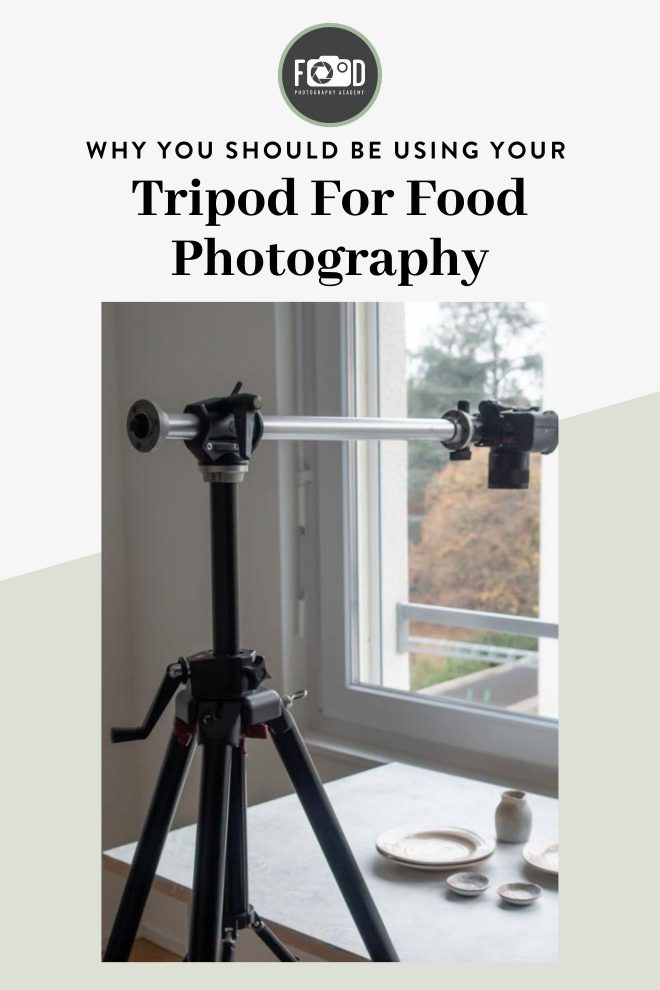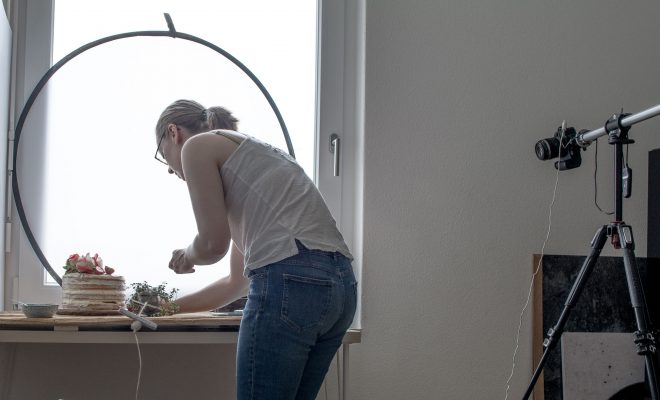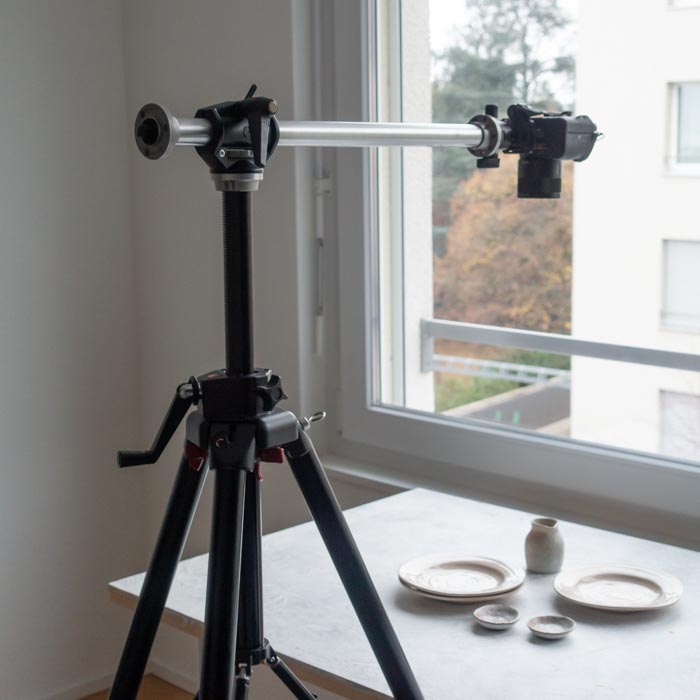One of the things I see so often in the food blogger world is a reluctance to use a tripod for food photography. I get it. Tripods are just these clunky, heavy things that get in the way of your creativity and freedom, right? WRONG.

Disclaimer: some of the links in this post are affiliate links, which means I may make a commission if you purchase something after clicking them. This results in no extra cost to you whatsoever.
A tripod is so much more than just a piece of metal to put your camera on. It’s a device that will literally transform your food photography, when you understand how to use one in conjunction with manual mode.
Not only does it take the weight of your camera for you, but it allows you to get into positions you can’t (safely) get into yourself, it locks your composition in place so you can style the shiz outta your food and nail it Every. Single. Time.
Seriously, am I too excited about tripods?
What is a tripod?
A tripod is a three legged device (hence the “tri”) that your camera attaches to. It helps stabilise your camera so you can get the absolute best out of it.
While tripods aren’t the most efficient for ALL kinds of photography, for food photography they are an absolute must.
If you’ve been holding off getting a tripod for whatever reason… I’m going to show you why you need to start using one! Plus I’ve included a free handy tripod toolkit, which gives you all the information you need to choose your tripod set up. With a range to fit all needs and budgets you can pick the best gear for you.
Before we jump into all the technical reasons a tripod will transform your food photography… let’s bust a few myths I’ve heard a lot…
Myth number 1: “I won’t be able to be as creative and free if I use a tripod for my food photography – it’s too restrictive”
WRONG! If anything, the total opposite is true. When you shoot using a tripod for food photography, not only will your image quality be infinitely better, but you’ll be able to absolutely NAIL your composition.
A tripod lets you choose the optimum position for your camera, then you can spend your time styling to the camera, which is effectively the eyes of the person viewing your photo. By using a tripod, those eyes aren’t going to move in between every shot you take, and you’ll be able to decide exactly where you want everything to be.
So really, you’re setting your creativity free!
Myth number 2: “A tripod is a waste of money, I’d rather spend more on a better camera”
Did you know that the price of your camera doesn’t reaaaaaaally matter?
It’s very easy to believe that more expensive = better when it comes to cameras, but this isn’t always the case. Sure, there are some swanky features included in a lot of the pricey DSLR’s, but spending extra money on a camera won’t automatically make your photography better.
What will make it better, is learning how to use your camera to it’s full potential. And what’s one thing that can help unlock a whole new level of awesome in your camera? You guessed it – a tripod.
If you invest in a good tripod, you’ll be able to get some absolutely incredible images out of most DSLR’s (I shot a food magazine cover on a $300 DSLR). Because when you lock down the camera, you’re able to harness the full power of manual mode. Without a tripod for food photography, you’ll always be a bit limited.
If you’re not using manual mode yet – fear not! Why not take our FREE 5 day e-course, Manual Mode Master? Learn more here!
Myth number 3: “Tripods are too heavy and bulky”
You’ll probably want to keep your equipment as light and small as possible if you’re a travel photographer, or you’re hiking up a mountain to get your shot… but I’m guessing you’re not hiking up a mountain to take your food shoot?!
Setting up your tripod only takes a matter of seconds, and moving it around between different shots can be pretty speedy as well if you’ve planned your composition.
Plus, if having a lightweight tripod is still really important to you, there are about a gazilion different options out there now, in all different kinds of strong, sturdy and lightweight materials.
Because this kinda research can take HOURS (believe me, I know) I’ve made you a handy tripod toolkit, giving you all the options and information you need to fit ALL needs and budgets. Download it for free below!
Ok, now we’ve busted those myths, let’s jump into the technical part of why you should use a tripod for food photography.
How using a tripod for food photography will help you BOSS your food shots
Shutter speed flexibility
First, let’s have a quick recap on what shutter speed is:
Shutter speed = The amount of time the shutter remains open when taking a picture, and therefore how much light can reach the camera’s sensor. The speed of the shutter is shown as fractions or multiples of a second. For example 1/80 = 1 80th of a second, 2” = 2 seconds.
If you shoot using natural light, you may find there are times of the day/year where the light isn’t optimal, and you need to somehow increase your exposure. There are three ways to increase your exposure using your camera: by widening your aperture, increasing your ISO, or slowing down your shutter speed.
But here’s the thing. Shutter speed is the only one of those settings that doesn’t have an artistic impact on your photo (when shooting a static subject). Changing the aperture will change your depth of field (how much of a blurry background your photo has) and upping the ISO will cause more visible grain. So really, you WANT to slow down your shutter speed to increase your exposure.
Ok, so we’re agreed that slower shutter speeds are the way to go… except that slower shutter speeds can be an issue when taking handheld shots of your food photography, as you’re more likely to get a blurred photo. Even the slightest movement will make your photo blurry if your shutter speed is anything slower than around 1/60 of a second.
Mounting the camera on a good tripod will mean you can get a sharp photo at much longer shutter speeds. This will give you much more flexibility if you’re limited on light due to a small window or the late afternoon!
Composition
Using a tripod for food photography helps with more than just the technical camera settings… it also helps you TAKE better photos.
If you shoot freehand, you’ll set up your scene, spend a long time getting everything just right, then set up to take your photo, look in your viewfinder, want to change one little thing and never be able to get back to exactly the same place again.
Just like I said before, when you shoot with a tripod, you have the flexibility to place your camera EXACTLY where you want the viewers eye to see your photo from, and then style to the camera. Your composition skills will improve exponentially.
Related: My top 5 Food Styling Tips
Using a tripod will also increase the variety of shots you can take. Even if you’re a one man band (like I am), by using a tripod you’ll be able to include your own hands and actions in your shot by setting up your camera and using a self timer.
You can use manual focus
Manual focus, when used properly, is just sharper than auto focus.
If you’re shooting handheld, you could set your focus perfectly, but a movement of only a couple of millimeters will change your focus point, so you won’t get that perfectly tack sharp shot.
Perhaps you might think changing to the right auto-focus mode might help (AF-S or AI Servo)… but it’s still not going to be as accurate as when everything is dead steady on a tripod.
If you lock your camera down on a tripod, you can use your live view or tethering screen to zoom right in on the area you want to focus, turn the focus ring of your lens to exactly the right point (yes, I promise it is still better than auto focus!!) and then take your shot without moving at ALL.
Hello tack sharp food photos.
And trust me, this will make your photos look 👌 professional.
Your Health
If you’re like “whaaaaa has a tripod got to do with my health?!” right now then hear me out…
I often spend 6-7 hours a day shooting food, sometimes more. A tripod stops me having to bend over at the waist to capture top down shots, or crouch down every single time I need to take a neutral angle shot.
It’s definitely not something to be taken for granted in this food photography world… your body is important, and a tripod will help you maintain good posture and avoid unnecessary strains and pains that can build up over time.
How to choose a tripod for food photography
Ok, so now we’ve established that you need a tripod for food photography, it’s time to start breaking down how to choose one. There are a million different options out there. To help save you time and effort, I’ve compiled you a list of my favourite tripods, in a full range of budgets, so you can find one that suits you!
There are three main parts to your tripod setup, and there’s a multitude of different options available for them. Before going into the details of these options, I’m going to share with you my tripod setup for food photography.
My Tripod for Food Photography Setup

Starting off with the tripod legs, I use the Manfrotto MT190XPRO4. It’s good value for money for the features it has. As well as having fully individually adjustable legs, it has Manfrotto’s “Q90 centre column”, which allows you to set the centre column perpendicular to the tripod for top down shots.
I actually don’t use the centre column in its Q90 mode, as I find it’s not quite long enough to keep the legs out of the shot in my studio set up. To nail these flat lays, I use the Manfrotto 131D Side Arm. This also means I can still extend the centre column upwards for added height.
Finally, I attach the Manfrotto 496RC2 Ball Head to the end of the tripod arm. The tripod head is what you mount the camera to. While this head provides flexibility to quickly change the angle of a shot, I sometimes would prefer more precision and control in the changing my camera angles, so may consider getting a pan/tilt head in the near future.
Now let’s explore the details of each part of a tripod setup, and the main options available to you:
Tripod Legs
These are the part of your tripod that will determine how stable it is, and therefore how well it will function. If you try and put a heavy DSLR on a “light, compact travel tripod”, you’re going to feel the instability, and all the reasons you bought a tripod in the first place won’t be solved.
Tripod legs are typically made of aluminum, basalt, steel or carbon fiber.
Carbon fiber tripods are the lightest and the most stable, but come with a higher price tag. Cheaper, lighter tripods are often made from aluminium.
You should also consider how high you need your tripod to be, and choose a tripod that has legs which will extend as high as you need.
Tripod Head
Most tripods will come without a head, which is a good thing, as you can really choose the one you want!
When you buy a tripod head, it will tell you how much weight it can support. You should weigh your camera + your heaviest lens together, then choose a tripod head that can support at least 1.5x as much weight, preferably 2x.
There are two types of tripod head which are normally useful in food photography, a 360° rotating “ball” head, or a pan-tilt head.
A ball head will allow you to smoothly move the camera any way you like, whereas a pan-tilt head will allow you to move the camera up and down and side to side one at a time.
Centre Column
This is like the 4th leg of your tripod. The centre column literally raises your camera up and down, so again, make sure it goes as high as you need, although it’s more stable to rely on the legs for height and not the centre column.
Some tripods feature a “tilting” centre column, which means you can tilt it at a 90° angle to capture flat lays. A nice feature, but often they aren’t long enough to capture a whole scene without getting legs in the photo, like I find with my tripod!
Overhead Arm
The answer to your centre column tilting worries. An overhead arm is an extra piece of equipment you can buy for your tripod to allow you to take straight down, 90° “flat lays”.
A good overhead arm is an essential part of my food photography process as I take a flat lay shot of nearly every dish I shoot. In the long run, an overhead arm will also save your back – no more bending over for the perfect flat lay!
Still confused about the best tripod for food photography? Well lucky for you we’ve compiled a list of 6 different tripod options, plus tripod heads and overhead arms in a range of budgets, so you should be able to find something in here to suit your needs! Download it for free below!
Summary
- A tripod is an essential piece of equipment for food photography.
- It won’t hinder your creativity! On the contrary, it will help you get into more positions to expand your possibilities.
- A tripod will help you take better quality, sharper photos, by providing extra stability.
- You’ll gain greater control over your photo composition, and therefore improve your food styling skills.
- A tripod will help save your back and joints in the long run, as it allows you to maintain good posture.
Your Turn
Are you already using a tripod for food photography? Do you have a favourite? And if not, what’s the one thing holding you back?

your explanation above are well presented and reader friendly, thanks a million.
Forgot to mention that my tripod is SLIK PRO300DX.
What’s the difference between Overhead Arm and Side Arm. I want to take 90-degree-photos, should I get side or overhead? I have a tripod, but not the Manfrotto, so I wonder if it will fit for any tripod?
Thank you!
Angie
Hi Angie! An overhead arm will sit perpendicular to your tripod allowing you to take top down shots. You would need to check the attachment on your specific tripod to see if the arm would fit.
Hi Lauren! I love my tripod and fully agree with all your points! I just wanted to mention that shutter speed does have an artistic impact on food photos, when you are shooting an action shot, like a hand pouring syrup over pancakes. Slowing down your shutter speed too much can create motion blur and you get two “syrup lines” instead of one if the hand moves at all. If your creative decision is to create blur to suggest movement, then a slow shutter speed works, but otherwise, I keep the shutter fast and instead play with the ISO if… Read more »
Hi Diana! Thanks so much for your comment. You’re totally right about using shutter speed in that way – in fact one of the lessons in my e-course is going to be all about creating those perfect “freeze frame” style action shots. My point was more about typical still frame shots, and how you can use the shutter speed to affect the exposure in those kinds of images 🙂
So glad you’re a fellow tripod lover, and thanks for the comment 😀